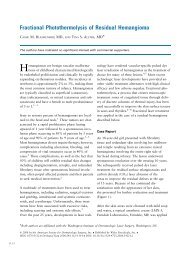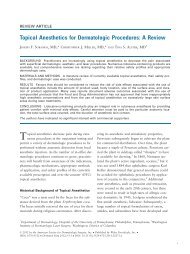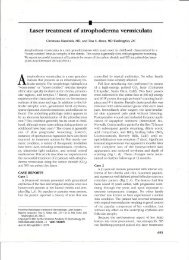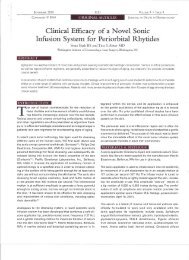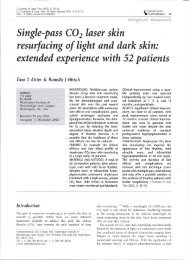Optimizing Treatment Parameters For Hair Removal Using A
Optimizing Treatment Parameters For Hair Removal Using A
Optimizing Treatment Parameters For Hair Removal Using A
You also want an ePaper? Increase the reach of your titles
YUMPU automatically turns print PDFs into web optimized ePapers that Google loves.
- ~I<br />
tient) was not achieved. All treatment sites exhibited full<br />
hair regrowth by 6 months, with some patients demonstrating<br />
regrowth as early as 1 and 3 months. While the<br />
ideal goal of laser-assisted epilation is permanence, the<br />
results of this study are consistent with those of previous<br />
studies involving single-session laser hair removal.<br />
Goldberg' reported that Q-switched Nd:YAG laser treatment<br />
and application of carbon solution provided a reduction<br />
in hair growth for up to 6 months. Grossman et<br />
aP reported a delay in hair growth for a 6-month period<br />
after long-pulsed normal-mode ruby laser irradiation. This<br />
apparent lack of permanence after laser hair removal has<br />
been disappointing, but not entirely unexpected, considering<br />
the vulnerability of hair to treatment at different<br />
phases in its growth cycle. Electrolysis, for example,<br />
requires numerous treatment sessions to effect a permanent<br />
reduction in hair growth. 7In a similar manner, it is<br />
quite possible that permanent epilation will emerge a reality<br />
only after multiple laser treatments.P Repeated laser<br />
injury to the hair follicle, which was not examined<br />
in the current study, should be investigated. Future studies<br />
should also address the question ofwhether laser light<br />
simply induces a prolonged telogen hair cycle or whether<br />
irreversible follicular damage is possible. Ultimately, histologic<br />
examination of treated hirsute sites will be necessary<br />
to fully understand the mechanisms of laserassisted<br />
hair re~oval.<br />
Although pretreatment with wax epilation and a topical<br />
carbon solution resulted in significant hair removal,<br />
this protocol was not essential. All laser-treated sites<br />
showed less hair regrowth at 3 months than the waxepilated<br />
control quadrants, suggesting that the laser energy<br />
can target the follicle without an exogenous carbon<br />
chromophore. However, because of the limited<br />
number of anatomic regions treated in this study, we<br />
lacked the statistical power to determine if a particular<br />
pretreatment protocol was superior to another.<br />
It is interesting to note that the quadrants that were<br />
simply exposed to laser radiation without waxing or carbon<br />
solution did not show a significant reduction in hair<br />
growth until the third month. This finding may be attributed<br />
to the fact that, in areas that were not wax epilated,<br />
laser irradiation caused the terminal hairs to whiten<br />
but to remain in the follicles. Although the hair shafts<br />
were injured, hair counts at 1 month included these depigmented<br />
hair shafts. By the third month, however, the<br />
injured hairs had fallen out of the follicles and a significant<br />
reduction in hair counts was recorded.<br />
While the results of this study suggest that wax epilation<br />
and/or carbon-based solution application is not essential<br />
to the laser-assisted hair-removal process, it is important<br />
to note that all study subjects had brown or black<br />
hair. When blonde or white hair-bearing areas are being<br />
treated, exogenous carbon pigment application may play<br />
a more important role in selectively targeting and concentrating<br />
laser energy into the follicle. Presumably,<br />
melanocytes and melanin within the hair follicle and shaft<br />
are the primary targets of Q-switched Nd:YAG laser energy<br />
when the laser treatment is used without a carbon<br />
solution. These melanin-producing cells are located within<br />
the hair matrix at the base of the follicle, the infundibulum,<br />
and sparsely within the outer root sheath.P" As there<br />
are greater numbers of melanocytes within the hair follicle<br />
than there are within the epidermis, laser energy can<br />
pass through the skin surface and be absorbed selectively<br />
by follicular melanin." This selective process obviously becomes<br />
more problematic when lighter hair colors are being<br />
treated. Gray hair, for instance, has fewer melanocytes<br />
at the hair bulb, and blonde hair has a decreased<br />
number of partially pigmented melanosomes as compared<br />
with black hair." Therefore, exogenous pigment in<br />
the form of a carbon-based solution may be helpful in the<br />
treatment of individuals with lighter hair colors.<br />
In conclusion, a single treatment with a Q-<br />
switched Nd:YAG laser results in a greater delay of hair<br />
growth (up to 6 months) when compared with wax epilation<br />
alone. Regardless of the use of pretreatment wax<br />
epilation or carbon topical solution, hair growth was decreased<br />
when compared with control (waxed) areas. Complete<br />
hair regrowth occurred by 6 months after a single<br />
treatment, suggesting that further research is needed to<br />
determine the optimal treatment intervals, energy settings,<br />
wavelengths, and pulse durations needed to achieve<br />
longer-lasting or permanent laser-assisted hair removal.<br />
Accepted for publication August 18, 1997.<br />
Reprints: Tina S. Alster, MD, Washington Institute of<br />
Dermatologic Laser Surgery, 2311 M St NW, Suite 200,<br />
Washington, DC 20037.<br />
REFERENCES<br />
1. Goldberg OJ.Topical solution-assisted laser hair removal Lasers Surg Med. 1995;<br />
suppl 7:47. Abstract.<br />
2. Goldberg OJ. Topical suspension assisted laser hair removal: treatment of axillary<br />
and inguinal regions. Lasers Surg Med. 1996;suppI8:195. Abstract.<br />
3. Grossman MG, Dierickx G, Farinelli W, et al. Damage to hair follicles by normalmode<br />
ruby pulses. JAm Acad Dermatol. 1996;35:889-894.<br />
4. Grossman MG, Wimberly J, Dwyer P, et at. PDTfor hirsutism. Lasers Surg Med.<br />
1995;suppl 7:47. Abstract.<br />
5. Alster TS. Manual of Cutaneous Laser Techniques. Philadelphia, Pa: Lippincott-<br />
Raven Publishers; 1996:128-134.<br />
6. Anderson RR, Parrish JA. Selective photothermolysis: precise microsurgery by<br />
selective absorption of pulsed radiation. Science. 1983;220:524-527.<br />
7. Richards RN, Meharg GE. Electrolysis: observations from 13 years and 140,000<br />
hours of experience. JAm Acad Dermatol. 1995;33:662-668.<br />
8. McKee PH. Pathology of the Skin. London, England: Mosby-Wolfe; 1996:1.20-<br />
1.21.<br />
9. Olsen EA. Disorders of <strong>Hair</strong> Growth. New York, NY: McGraw-Hili Book Go; 1994:<br />
52-55.<br />
/<br />
ARCH DERMATOUVOL 133, DEC 1997<br />
1549<br />
Printed and Published in the United States of America




